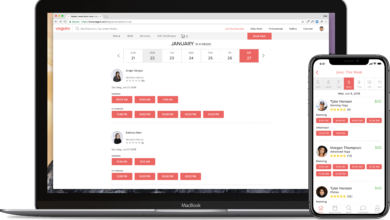Cross-platform app development using Flutter refers to the process of creating mobile applications that can run on multiple operating systems, including iOS, Android, and even web platforms, using the Flutter framework. Flutter is an open-source UI toolkit developed by Google, which allows developers to build high-performance, visually appealing apps with a single codebase.
As a leading Flutter development company, we leverage the power of Flutter to deliver seamless and feature-rich mobile applications across multiple platforms. With Flutter, developers write code in Dart programming language, and the framework compiles it to native code for each target platform.
Key Features Of Flutter
Developed by Google, Flutter is an open-source UI toolkit explicitly crafted to enable developers to create natively compiled applications for mobile, web, and desktop platforms. Its unique strength lies in building robust apps from a single codebase, saving time and effort while ensuring consistent quality across multiple platforms. It enables developers to create visually stunning and high-performance apps with a rich user interface. Here’s an introduction to its key features:
- Single Codebase: With Flutter, developers write code once in the Dart programming language and can deploy it across multiple platforms, including iOS, Android, web, and desktop. This saves development time and effort by eliminating the need for separate codebases for each platform.
- Fast Performance: Flutter apps leverage the power of compiling to native ARM code, enabling them to execute directly on the device’s hardware, ensuring optimal performance and seamless functionality. This results in fast and responsive user interfaces with smooth animations and excellent performance.
- Hot Reload: One of Flutter’s most celebrated features is hot reload, which enables developers to see the changes they make in the code reflected in the app’s UI in real-time. This speeds up the development process and allows for quick iterations, experimentation, and bug fixing.
- Rich Set of Widgets: Flutter provides a wide range of pre-built UI components called widgets. These widgets are highly customizable, allowing developers to create visually appealing interfaces with various styles and layouts. Widgets can be combined and nested to build complex UIs quickly and efficiently.
- Access to Native Features and APIs: Flutter offers a rich set of plugins and packages that provide access to native device features and APIs. This means developers can easily integrate functionalities like camera, geolocation, sensors, storage, and more into their Flutter apps.
- Material Design and Cupertino Style: Flutter provides ready-to-use widgets that adhere to the Material Design guidelines for Android apps and Cupertino style for iOS apps. This ensures that Flutter apps have a native look and feel on each platform, providing a familiar and consistent user experience.
- Flutter Web: Flutter has expanded its capabilities to include web development. Developers can now use Flutter to build responsive and performant web applications using the same codebase they use for mobile apps.
- Strong Community and Ecosystem: Flutter has a rapidly growing and enthusiastic community of developers, contributing to its vibrant ecosystem. This means there is an extensive range of third-party packages, libraries, and tools available, providing additional functionality and enhancing the development experience.
Overall, Flutter offers a powerful and efficient platform for cross-platform mobile web development, allowing developers to build beautiful, high-performance apps with a single codebase. Its key features, including hot reload, rich set of widgets, and access to native features, make it a popular choice for creating mobile, web, and desktop applications.
When it comes to custom mobile app development, Flutter provides a flexible and versatile framework that enables us to create tailored solutions to meet your unique business needs. Our team of skilled developers specializes in crafting custom mobile apps using Flutter, ensuring a seamless user experience and optimal performance across multiple platforms. Partner with us for top-notch custom mobile app development services.
Advantages of Flutter
A. Single Codebase for Multiple Platforms: With Flutter, developers can write code just once and deploy it effortlessly across a wide range of platforms, including iOS, Android, web, and desktop. This streamlined approach eliminates the need for separate codebases, saving valuable time and effort while ensuring a consistent user experience across various devices and platforms. This significantly reduces development time and effort by eliminating the need for separate codebases for each platform.
B. Fast Development and Hot Reload Feature: Flutter’s hot reload feature enables developers to see the changes they make in the code immediately reflected in the app’s UI, without the need for a full app restart. This speeds up the development process, facilitates experimentation, and allows for quick bug fixing and iteration.
C. Beautiful and Customizable User Interfaces: Flutter provides a rich set of pre-built UI components called widgets, which are highly customizable. Developers can create visually stunning and unique user interfaces by combining and customizing these widgets to match their design requirements.
D. High Performance and Native-like Experience: Flutter apps are compiled to native ARM code, enabling them to run directly on the device’s hardware. This results in high-performance apps with smooth animations, fast rendering, and a responsive user interface, providing a native-like experience across different platforms. Building mobile applications using Flutter cross platform capabilities allows them to run seamlessly on multiple devices without any glitches or performance issues.
E. Strong Community Support and Ecosystem: Flutter has a thriving community of developers who actively contribute to its growth and provide support to fellow developers. This vibrant community has led to the development of numerous third-party packages, libraries, and tools, expanding the capabilities of Flutter and providing a rich ecosystem for developers to leverage.
These advantages make Flutter an attractive choice for cross-platform app development, as it streamlines the development process, allows for faster iteration, empowers developers to create visually appealing interfaces, delivers high-performance apps, and offers a supportive community and ecosystem for assistance and enhancement.
A flutter mobile app works seamlessly on multiple platforms, including iOS, Android, and web, using a single codebase. By leveraging Flutter, developers can save significant time and effort that would otherwise be spent on building individual apps for each platform. Instead of duplicating development efforts, Flutter allows for efficient code sharing and reusability, resulting in streamlined development processes and accelerated time-to-market.
Growing Popularity and Adoption of Flutter
A. Success Stories of Companies Using Flutter: Many companies have found success in adopting Flutter for their app development needs. Some notable examples include:
- Google: Google itself has utilized Flutter for developing applications like Google Ads, Google Assistant, and Google Stadia.
- Alibaba: Alibaba, the e-commerce giant, has employed Flutter to build several apps, including Xianyu, an online marketplace app with millions of users.
- Reflectly: Reflectly, a popular mindfulness and journaling app, chose Flutter to deliver a visually appealing and responsive user experience.
- Tencent: Tencent, a leading technology conglomerate, utilized Flutter for the development of its game streaming platform, NOW Live.
These success stories demonstrate the capabilities and effectiveness of Flutter in real-world scenarios.
B. Increased Demand for Cross-Platform Development: The demand for cross-platform app development has been steadily rising due to several factors. Companies and developers recognize the benefits of building apps that can run on multiple platforms, as it saves time, effort, and resources. Flutter’s ability to provide a single codebase for multiple platforms positions it well to meet this increased demand for cross-platform development.
C. Comparison with Other Cross-Platform Frameworks: Flutter stands out among other cross-platform frameworks due to its unique features and advantages. When compared to frameworks like React Native, Xamarin, and Ionic, Flutter offers:
- Native Performance: Flutter’s compilation to native ARM code ensures high performance and smooth animations, providing a native-like experience.
- Hot Reload: Flutter’s hot reload feature allows for faster development cycles and real-time feedback, enabling quicker iterations and bug fixing.
- Customizable UI: Flutter’s rich set of customizable widgets allows developers to create visually stunning and branded user interfaces with ease.
- Strong Community and Ecosystem: Flutter has gained significant community support, with a growing ecosystem of packages and tools, making it easier for developers to find resources and solutions.
These factors contribute to the growing popularity and adoption of Flutter, as it offers distinct advantages over other cross-platform frameworks and aligns well with the needs of developers and businesses in the current app development landscape.
Flutter’s future roadmap includes several key areas of development and improvement:
A. Expansion into Additional Platforms: Flutter has already made significant strides in cross-platform app development for iOS, Android, web, and desktop. However, the Flutter team aims to expand its reach further by targeting additional platforms. This includes efforts to support embedded devices, smart TVs, wearables, and emerging platforms, broadening the scope of Flutter’s applicability.
B. Integration of New Features and Capabilities: The Flutter team continuously works on integrating new features and capabilities to enhance the framework. This includes improvements to existing widgets, the introduction of new widgets, and the addition of new APIs and functionalities. For example, Flutter has introduced features like desktop support, foldables and dual-screen devices support, and improved accessibility features.
C. Improvements in Performance and Stability: Flutter’s performance and stability have already garnered praise, but the team remains committed to refining and optimizing the framework further. This includes ongoing efforts to reduce app size, enhance rendering performance, and improve overall stability. Flutter’s JIT (Just-in-Time) compiler will transition to a more efficient and faster AOT (Ahead-of-Time) compilation by default, resulting in improved startup times and overall performance.
D. Accessibility and Internationalization: Flutter acknowledges the importance of accessibility and internationalization in app development. The team is actively working on improving accessibility features and tools within the framework, ensuring that Flutter apps can be used by a wider audience and meet internationalization requirements seamlessly.
E. Tooling and Developer Experience: Flutter aims to provide a robust and developer-friendly environment. The team is dedicated to enhancing the tooling and developer experience by improving IDE integrations, debugging capabilities, and providing more comprehensive documentation and resources. This ensures that developers can efficiently build, test, and maintain Flutter apps.
F. Continued Community Engagement: Flutter has a thriving community of developers, and the team actively engages with the community to gather feedback, address issues, and incorporate community-driven enhancements. The collaboration between the Flutter team and the community ensures that the framework evolves in line with the needs and expectations of developers.
These focus areas reflect Flutter’s commitment to continuous improvement, expanding its reach, and addressing the evolving needs of developers and app development across platforms.
Conclusion
Flutter is a powerful and versatile cross-platform development framework that offers numerous advantages for app development. Its ability to provide a single codebase for multiple platforms, along with its fast development cycles and hot reload feature, significantly enhances productivity and efficiency for developers. The framework allows for the creation of beautiful and customizable user interfaces, delivering visually appealing apps with a native-like experience. Flutter’s strong community support and ecosystem further contribute to its appeal by providing resources, packages, and assistance to developers.
Author Bio
Ashish Jain is the global head of offshore strategic partnerships at AddWeb Solution, a renowned Flutter development agency delivering innovative solutions to meet clients’ needs. With expertise in the latest software technologies, he has a reputation for delivering flexible and dependable flutter development services to clients across a range of industries.





